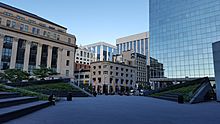Bank of Canada Museum facts for kids

The new Bank of Canada Museum. The entrance is on the bottom left.
|
|
| Established | 1980 |
|---|---|
| Location | Ottawa, Ontario, Canada |
The Bank of Canada Museum is a fun and interactive museum in downtown Ottawa, Canada's capital city. It used to be called the Currency Museum. Its job is to teach Canadians about money, how our country's economy works, and what the Bank of Canada does.
The museum is located underground, right below the main Bank of Canada building. It's packed with hands-on exhibits and games that show you how you are a part of the economy. You can see over 1,000 examples of money from Canada and all over the world.
It is home to the National Currency Collection, which is the most complete collection of Canadian coins, bank notes, and money tokens ever gathered. The museum also offers lots of online tools to help students learn about money and economics. Best of all, it's Canada's only national museum that is completely free to visit!
Contents
History of the Museum
The museum first opened in 1980 as the Currency Museum. It was a place to show off the amazing National Currency Collection. It was located on the main floor of the Bank of Canada building.
Building the National Currency Collection
In the late 1950s, the head of the Bank of Canada, James Coyne, had the idea to create a national collection of money. The Bank hired experts to find items that told the story of Canadian money over 150 years.
In 1962, Sheldon S. Carroll became the first curator. He was told to build the best collection possible of Canadian coins, tokens, and paper money. He also collected money from ancient and modern times from other countries.
The museum got many of its cool items from collectors and companies.
- In 1963, it bought the collection of J. Douglas Ferguson, a famous Canadian money expert. This included paper money from when Canada was a French colony.
- In 1965, Library and Archives Canada transferred a large collection of coins to the Bank.
- In 1974, the Bank bought a huge collection from the Château de Ramezay in Montréal. This included items from R.W. McLachlan, who was Canada's top money expert in the late 1800s.
In 1977, the government officially named it the National Currency Collection. Today, it includes coins, banknotes, tools for making money, and even examples of counterfeit (fake) money.
A Brand New Museum
The original Currency Museum stayed mostly the same for over 30 years. In 2013, it closed for a huge renovation. It reopened on Canada Day, July 1, 2017, as the new and improved Bank of Canada Museum.
A Modern, Interactive Museum
The new Bank of Canada Museum is designed to be a fun experience for everyone. When you arrive, you get to create your own cartoon avatar on a touch screen. You get a special wristband that connects to the exhibits, and your avatar follows you around the museum on different screens.
Fun and Games
The museum is filled with interactive games that teach you about the economy.
- The 2% Rocket: You can sit in a cockpit and fly a spaceship. Your goal is to keep your speed just right to hit a target of 2%. This is the same target the Bank of Canada has for inflation (the rate at which prices for goods and services rise).
- Design Your Own Banknote: You can get creative and design your very own money, choosing the pictures, colours, and security features.
Exploring the History of Money
The museum also teaches you about the history of money. Display cases show hundreds of examples of currency. While it focuses on Canadian money, you can also see coins, banknotes, and trade items from all over the world, some of which are thousands of years old.
The museum often has temporary exhibits. Past exhibits have included "A Noteworthy Woman," about human rights hero Viola Desmond, who is on Canada's $10 bill. Another was "Money in 10 Questions: Kids Edition," which was designed to help kids learn about money.
Learning About Money
A big part of the museum's job is education. It has created over 40 lesson plans, activities, and videos for students and teachers. These resources help teach economics in elementary and high schools. The museum's website also has a large collection of blog posts about money for everyone to enjoy.
In 2022, the museum started an award to celebrate Canadian teachers who do an amazing job of teaching students about money and the economy. In 2024, the museum had over 68,000 visitors and its programs reached more than 8,400 students.

